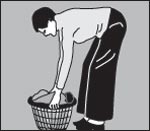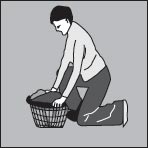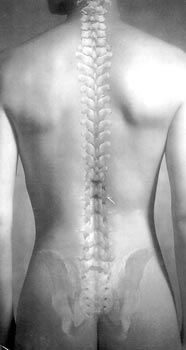When you come down with a lower back pain
By Esther Williams
Plagued by persistent lower back pain? You are not alone in this as four out of five suffer from the common phenomenon that is second only to the common cold, at some point in their life. “Most however recover from the pain which is a result of poor posture or muscle strain and carry on regular activities within a short time,” assures Consultant Rheumatologist, Dr. Lalith S. Wijayaratne.
Significantly, one can get bouts of back pain more often from being sedentary than from overloading the muscles. This is because when sedentary, muscles become weak and flabby and are unable to function as shock absorbers to the spine leading to pain and injury at the slightest movement.
The back is made up of muscles on either side of the spinal column, which serve the purposes of absorbing shock, providing strength and acting as a stabilising agent. The spine on the other hand has 24 bones arranged vertically from the skull on top to the pelvic bone at the base with muscles and ligaments to keep it in position. Awkward movements or over-straining the muscles that bear the most weight from everyday activities can cause pain.
Back pain can be localized at the back or sometimes travel to the limbs as a referred pain. Here are the common causes:
- Simple strain: The commonest cause for back pain is a simple strain of the muscle, which is also termed as pulled muscle or ligament. Though this can initially cause excruciating pain, complete recovery is possible within a short time. However such injuries small as they are may at times cause splinting or spasms (tightening of muscles) that can add to the existing pain.
- Poor posture: Poor posture too can cause simple strain of the ligaments and muscles of the back. This can happen when people slouch in their seats, or remain in the same position for hours on end with inadequate support for the back.
- Slipped Disc: In between the bones of the spine are discs containing a jelly-like substance that can rupture and leak out to press on the nerve. The condition is common among younger people who bend and lift objects heavier than they are capable of.
- Sciatica: When a slipped disc touches the sciatic nerve that controls the movements of the lower limbs it can cause pain in the lower back, buttock, back of the thigh, knee, ankle, etc. Rarely, this condition can cause weakness in the feet and inability to control passing of urine.
- Lumbar Spondylosis (wear and tear): As a person ages, the water content in the discs as in the rest of body reduces, affecting the flexibility of the spine and its capacity to absorb shock. Further, spurs of bone also called osteophytes (extra growth) may form at the edges of the vertebrae and joints making the space between the vertebrae narrower. This causes vibration within the bones, resulting in pain.
- Spinal Stenosis or narrowing of the spinal canal: Prolapsed discs, osteophytes or thickening of spinal ligaments can cause this condition. In this process nerve roots get compressed causing shooting pain. Persons with this condition cannot walk long distances as pain is also felt in the thighs and sometimes in the lower leg.
- Other: Persistent back pain is sometimes associated with latter months of pregnancy, osteoporosis, infection such as tuberculosis and rarely from tumours and arthritis. Stress too can cause muscle spasms resulting in pain. In heavy smokers changes take place in the disc and vertebra causing pain.
 |
 |
| What you shouldn’t do |
What you should do |
Coping with a backache:
- Painkillers and rest: Most backaches that are caused by pulled muscles can be healed with painkillers, which allow the sufferer to continue work, even if perhaps at a lower capacity. Occasionally, bed rest for about 3-4 days is advised so that the activity that causes pain is avoided.
- Correct posture: It is important to maintain correct posture while lying down, sitting, standing and driving. While lying down, a firm bed is vital. If necessary a plank should be placed under a thin mattress to prevent sagging. It is always better to lie flat, use a thin pillow and refrain from watching TV or reading in bed.
While seated the chair should be pulled close to the table with a chair back that supports the entire lower back. Feet should be placed flat on the ground with a 90-100 degree angle at back/hip and knee. Similar caution should be observed while driving, pulling the seat to a proper distance from the steering wheel that allows proper back support and 90 degree angle at knee and allowing for room to press the brake/clutch. If necessary a cushion can be used to give height or additional support to the back, keeping to the natural curve of the spine. In addition, taking a 30 second walk after every 90 minutes of driving is especially essential for those spending several hours on the road.
IT professionals and secretaries are advised to simply stand and sit every half hour. As for housewives who may have stacks of ironing that is done standing, they need to keep a brick near the feet and rest each of the feet on it for a minute or so every half hour.
They are further advised not to bend too much but rather use an adjustable ironing table where the height can be adjusted to suit the height of the individual. It simply goes to say that all individuals need to programme the day in such a manner that they do not maintain the same posture for long. High heels that affect correct posture can also cause strain on the spine and hence should be avoided for regular work.
- Need to maintain ideal weight: “How much extra loading your spine can take depends on the strength of the back and stomach muscles,” Dr. Wijayaratne points out. Hence, needless to say, overweight causes spine strain. It is common for men with potbellies to experience lower back pain. With a sedentary lifestyle that caused the potbelly in the first place, the muscles around their waist get weak and flabby with too much fat and thus are unable to support the spine effectively.
- Exercise: The stomach and waist have a natural corset muscle that protects the spine. To keep this in good condition and prevent recurring backache one needs to exercise -using routines with a combination of stretching, strength building and general fitness as recommended by a doctor and a physiotherapist. These would change from person to person depending on the condition of the individual as the wrong exercise can make it worse. It needs to be noted that exercise of the affected muscle can reduce the spasm and improve its strength.
Notably, backaches can be avoided by preventing overloading of the back. Fortunately all backaches do not need x-rays for the muscle or ligament that is affected can recover within 3-4 weeks. If a physician feels that the pain is a result of pressing on a nerve due to Lumbar Stenosis, Sciatica or Slipped disc or a sinister cause such as an infection, tumour or a fracture, he may require a CT scan or an MRI.
Dr. Wijayaratne advises that a person continues to work normally as long as the pain is bearable. If the pain is severe, he advises 2-3 days of rest. Painkillers, injections and drugs are recommended for any inflammation and pain. Apparently less than 1% needs surgery. |



